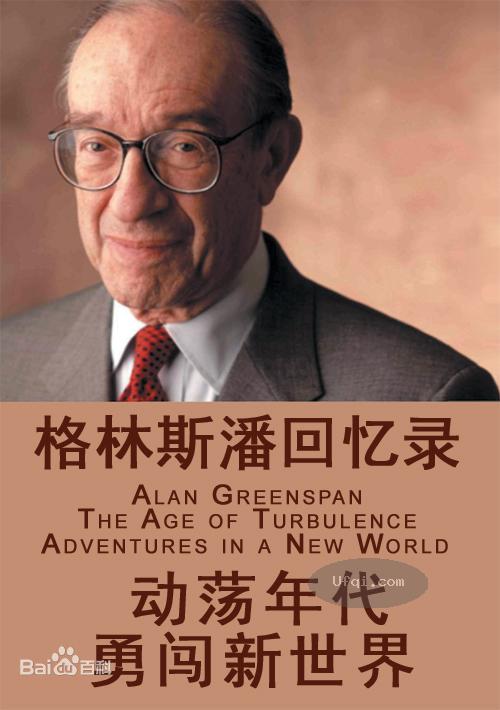


2023-05-03 , 8655 , 104 , 159
美国联邦储备委员会主席艾伦格林斯潘回忆录——动荡年代:勇闯新世界-the age of turbulence-19
美国最早具有中央银行职能的机构是1791年获批的美国第一银行和美国第二银行。
1837年至1862年间的“自由银行时代”美国没有正式的中央银行,而自1862年至1913年间,一个(私营的)国家银行系统起到了这个作用。
美联储是由美国国会在通过欧文·格拉斯法案(Owen-Glass Act,又称联邦储备法案)的基础上建立的,由伍德罗·威尔逊总统于1913年12月23日签字。
----
ECONOMICS MEETS POLITICS
On key issues Arthur Burns would sit in to advise. Many days there would be
twenty-five people in the room. This was a good forum in which to air issues,
but not a place to make the real decisions. The inner circle of economic advisers was much smaller: Treasury Secretary Simon, Budget Director Roy Ash (later his successor, Jim Lynn), Arthur Burns, and me.
At first it seemed as though all any of us did was bring the president bad news. In late September, unemployment suddenly ticked up. Soon orders,
production, and employment all started to fall. By Thanksgiving I was telling the president, "There's a possibility that we may have very severe problems going into next spring." On Christmas Eve, the policy group wrote a memorandum warning him to expect more unemployment and the deepest recession since World War II. It was not a nice present.
Worse, we had to tell him we didn't know how bad the recession would be. Recessions are like hurricanes—they range from ordinary to catastrophic.
The ordinary ones are part of the business cycle: they happen when business inventories exceed demand, and companies cut production sharply until the excess inventory gets sold. The Category 5 kind happens when demand itself collapses—when consumers stop spending and businesses stop investing. As we talked through the possibilities, President Ford worried that America would find itself trapped in a vicious circle of falling demand, layoffs, and gloom. Since none of the forecasting models could deal with the circumstances we were facing, we were flying blind. All we could tell him was that this might be an inventory-based recession, aggravated
by the oil shock and inflation—maybe a Category 2 or 3. Or it might be a Category 5.
The president had to make a choice. With the discomfort index nearing 20 percent, there was tremendous political pressure from Congress to slash taxes or massively pump up government spending. That was the way to deal with a Category 5. It could revive growth in the short term, though it risked pushing inflation even higher, with potentially disastrous long-term effects. On the other hand, if we were facing only an inventory recession,
the optimum response—economically, not politically—was to do as little as possible; if we could keep our hand off the panic button, the economy would correct itself.
Ford was not a man given to panic. In early January 1975, he instructed
67
us to develop the mildest possible plan. It ended up including steps to ease the



energy crisis, restraints on federal budget growth, and a onetime income-tax rebate to give families a boost. The rebate was the brainchild of Andrew Brimmer, a private-sector economist who'd served in the LBJ years as the first African American governor of the Federal Reserve Board. A few days before presenting the plan to the public, President Ford quizzed me closely on whether a $16 billion tax rebate would hurt our prospects for long-term growth. Economically speaking, the rebate was a prudent response, I told him, and explained, "As long as it's a one-shot deal and doesn't become permanent, it's not going to do much harm."
I was a little startled when he answered, "If that's what you think should be done, then I'll propose it." Of course, he was also consulting with advisers more senior than I. But I thought, This is interesting. The president of the United States is taking my advice. I felt a big sense of responsibility— and gratification. Ford didn't owe me anything, politically or otherwise.
Here was proof that ideas and facts did matter.
His restrained program made good economic sense. It jibed with my own decision-making philosophy. In reviewing a policy, I always asked myself the question, What are the costs to the economy if we are wrong? If there is no downside risk, you can try any policy you want. If the cost of failure is potentially very large, you should avoid the policy even if the probability of success is better than fifty-fifty, because you cannot accept the cost of failure. All the same, the choice President Ford made took a lot of political courage. He was well aware that his program would be denounced as inadequate—and that it might, if it proved too mild, prolong the economic slide.
I decided the CEA had to treat this as an emergency. The president needed to know whether we were facing a temporary inventory shock or a major meltdown of demand. The only surefire economic measure of that was the gross national product, a comprehensive description of the economy that the Bureau of Economic Analysis derived from a vast agglomeration of statistics. Unfortunately, the BEA produced the GNP only once per quarter—well after the fact. And you can't drive using a rearview mirror.
My idea was to rig up an emergency set of headlights: a weekly version of the GNP that would enable us to monitor the recession in real time. I
68
believed this was possible because at Townsend-Greenspan we'd developed a monthly GNP. It appealed to clients who had to make decisions and did not want to wait for the official quarterly figures to be announced. So the analytical foundation was there; creating a weekly measure would mostly mean more work. Some crucial statistics, such as retail sales and new unemployment-insurance claims, were already available on a weekly basis,
so those were easy. Other key data, such as auto sales or statistics on orders and shipments of durable goods (factory gear, computers, and so on), were normally reported every ten days or once a month. Inventory data too were monthly, with the further complication that the surveys were often inaccurate and subject to large revisions.
A way to fill these giant information gaps was to get on the phone. I'd built a large network of clients and contacts over the years in companies,
trade associations, universities, and regulatory agencies, and many of these people responded generously when we called to ask for help. Companies shared confidential information about their order books and hiring plans;
business leaders and experts guided us with their own observations and insights.
We were able to build a clearer picture of inventories, for example,
by combining this anecdotal information with sensitive measures of raw-materials prices, imports and exports, delivery schedules, and more.
The evidence we pulled together was still fragmentary—nowhere near the standard that the Bureau of Economic Analysis used in calculating GNP for public dissemination. But it fit our special needs. When the BEA economists and statisticians learned what we were trying to do, they pitched in and helped us structure our analysis. After two or three weeks of burning the midnight oil—our small staff was also busy preparing its annual assessment of the economy, which is published in early February—the weekly GNP system was up and running. Finally I was able to start going to President Ford with up-to-date facts instead of guesstimates.



UfqiLong
The policy issues came into much sharper focus after that. Each week,
at the regular cabinet meeting, I would update the picture of the recession.
As we looked at the ten-day auto sales figures, the weekly retail sales, the data on housing permits and starts, detailed reports coming out of the unemployment-insurance system, and so on, we became convinced that this was the milder kind of storm. Consumers, it turned out, were still buying
69
at a healthy rate despite all they'd been through. What was more; inventories were being liquidated at a very rapid clip, a pace that could not continue for long, or business would soon run out of inventories. This meant production soon had to rise to close the gap with consumption.
Thus I was able to tell the president and the cabinet that the recession was bottoming out. I said, with what for me was certainty: "I can't give you the exact date, but unless there is a collapse in consumer markets or housing,
it's got to happen that way." Week after week, the data were unequivocal—it turned out to be one of those rare, fortunate occasions in economics when the facts are clear and you can know for sure what is going on. So when the time came in March 1975 for me to testify in Congress, I had the strong conviction necessary to be able to say that America was moving toward a recovery "on schedule." I testified that we faced another bad quarter and that unemployment could hit 9 percent, and yet it was now possible to be "marginally optimistic." And I warned against panicky spending increases or tax cuts that would overstimulate the economy and trigger another inflationary spiral.
The political storm surrounding the president's economic plan that spring was something to behold. There was tremendous fear in Congress. I used to joke that I had to put on my bulletproof vest and armor when I'd go up to the Hill to testify. Newsweek put my picture on the cover in February 1975 under the headline "How Far Is Down?" Congressman Henry Reuss thought Ford, like Herbert Hoover in 1930, would let us slide into a depression, and was quoted saying, "The President is getting the same kind of economic advice that Herbert Hoover was given." When I appeared before the Senate Budget Committee, the chairman, Ed Muskie, asserted that the administration was doing "too little, too late." Congressmen were putting forward proposals to stimulate the economy that would have pushed the deficit to $80 billion and beyond, a horrendous figure at that time. George Meany,
the president of the AFL-CIO, was even more vociferous. "America is in the worst economic emergency since the Great Depression," he testified. "The situation is frightening now and it is growing more ominous by the day. This is not just another recession, for it has no parallel in the five recessions in the post-World War II period. America is far beyond the point where the situation can correct itself. Massive government action is needed."
Meany wanted the government to run a $100 billion deficit, including massive tax cuts for low- and middle-income families, to stimulate growth.
70
(未完待续, To be contd)



🔗 连载目录
🤖 智能推荐












